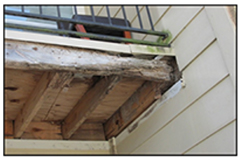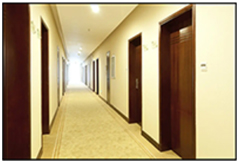
Reserve Studies
The Bedrock of Your Community’s Financial Plan
By Matthew Kuisle, PE, PRA, RS / Published May 2021

Each year, community associations develop annual budgets, which consist of income (i.e., owner assessments) as well as projected expenses (i.e., operating expenses, capital projects, and insurance premiums). Establishing a fair and impartial annual budget requires a clear understanding of the community association’s current and future needs and costs associated with each. A large part of most community association budgets is reserves, which fund capital expenditures.
A professional reserve study serves as a roadmap to properly maintain your community association’s common property through adequately funded reserves. Specifically, the reserve study determines how much to collect in annual reserve contributions so the board can afford capital projects when they are needed.
A professional reserve study comprises four parts:
- an executive summary
- a schedule of expenditures
- a funding plan
- detailed narratives
The Executive Summary contains high-level details, or better put, a 10,000-foot view of the association’s current reserve fund status and long-term funding needs. It commonly includes a table of annual contributions along with anticipated expenditures and year-end reserve balances. Furthermore, it highlights near-term major projects. The executive summary communicates the community association’s path to maintaining common property through adequately funded reserves.
The chart above incorporates anticipated expenditures, reserve contributions, and reserve fund balances by year. Association leadership is presented with a clear understanding of their community’s financial health and long-term funding needs. Following the reserve study professional’s reserve funding schedule minimizes the risk of additional assessments and/or decisions to defer critical capital projects.
The Schedule of Expenditures provides a detailed component inventory with a prioritized replacement schedule including itemized costs. The component inventory and future events, all in one place, provide association leadership with a complete picture of both near-term and long-term capital expenditures.
Each expenditure is prioritized to ensure the community association makes the most efficient use of reserve funds. The priority of each project is derived from the condition of the common elements at the time of the reserve study consultant’s site inspection as well as the criticality of repair or replacement. The total expenditures by year as well as the timing of capital-intensive projects (i.e., roof, siding, and pavement replacements) provide a clear understanding of reserve funding needs.
The Funding Plan serves as the financial roadmap to offset the capital expenditures outlined in the schedule of expenditures. The reserve study consultant develops recommended annual reserve contributions that fund future expenditures.
The funding plan should consider the funding goals of the association while establishing and maintaining adequately funded reserves for the purpose of maintaining common property, while minimizing the risk of additional assessments as your community association ages. Understanding the purpose of the reserve funding plan is critical to developing a comprehensive annual budget and to maintaining the physical condition of common property.
 Detailed narratives comprise component specific details geared towards educating community stakeholders on the condition of and best practices for maintaining and replacing each common element. The condition of each common element is well documented with high resolution images, which are supported by an explanation of expectations for remaining useful lives and repair or replacement schedules. This section of the reserve study report also indicates which projects could be deferred and which should only be deferred upon the recommendation of an independent professional.
Detailed narratives comprise component specific details geared towards educating community stakeholders on the condition of and best practices for maintaining and replacing each common element. The condition of each common element is well documented with high resolution images, which are supported by an explanation of expectations for remaining useful lives and repair or replacement schedules. This section of the reserve study report also indicates which projects could be deferred and which should only be deferred upon the recommendation of an independent professional.
The reserve study report should also include recommendations for preventive maintenance. Preventive maintenance is key to maximizing useful lives, to providing a level of flexibility with the timing of replacement, and to minimizing the total annual cost of ownership. Furthermore, routine maintenance minimizes the risk of emergency repairs as minor issues can be caught and addressed before they escalate.
As previously mentioned, the reserve study prioritizes each capital project, ensuring the most efficient use of reserve funds. As your property continues to age and deteriorate, the actual timing of each capital project may vary from what was originally projected in the reserve study. The condition of each common element should be monitored closely, and critical projects should be prioritized over those that are discretionary. This is especially important if reserve funds are not adequately funded.
 Critical capital projects are those that jeopardize the safety of residents and/or lead to more costly repairs if deferred. For example, deteriorated wood balconies can be a life safety hazard and a major liability. Furthermore, failure to address such an issue can lead to water infiltration into the building envelope, accelerating the rate of deterioration of siding, damaging structural components and insulation, and exposing individual units to water damage.
Critical capital projects are those that jeopardize the safety of residents and/or lead to more costly repairs if deferred. For example, deteriorated wood balconies can be a life safety hazard and a major liability. Furthermore, failure to address such an issue can lead to water infiltration into the building envelope, accelerating the rate of deterioration of siding, damaging structural components and insulation, and exposing individual units to water damage.
Discretionary projects, if deferred, are limited to affecting curb appeal of the association. For example, common area wall and floor coverings have no effect on the integrity of a building’s structure. Furthermore, the useful life or rate at which associations freshen up common areas is discretionary. Some may take issue with dated hallways. However, deferring a project of this nature or limiting its scope to common area lobbies (omitting hallways, stairwells, etc.) allows an association to focus on and dedicate limited reserve funds to projects of utmost importance.
 Understanding your community association’s current physical and financial situation begins with the preparation of a professional reserve study. Only then is one able to understand the community’s long-term needs. The prioritized schedule of capital projects and supporting funding plan supports the financial health of a community and serves as the bedrock of its overall strategic plan. Surely most associations will, at some point in the future, find themselves deferring or accelerating projects or spending more/less than planned on renovations. Ultimately, the success and health of a community will be measured by its ability to weather such differences. While “the best laid plans of mice and men often go awry,” conducting, updating, and implementing a professional reserve study will help boards maintain the common property in excellent condition for decades to come.
Understanding your community association’s current physical and financial situation begins with the preparation of a professional reserve study. Only then is one able to understand the community’s long-term needs. The prioritized schedule of capital projects and supporting funding plan supports the financial health of a community and serves as the bedrock of its overall strategic plan. Surely most associations will, at some point in the future, find themselves deferring or accelerating projects or spending more/less than planned on renovations. Ultimately, the success and health of a community will be measured by its ability to weather such differences. While “the best laid plans of mice and men often go awry,” conducting, updating, and implementing a professional reserve study will help boards maintain the common property in excellent condition for decades to come.
Matthew C. Kuisle, P.E., PRA, RS
Regional Director and Shareholder, Reserve Advisors
Matthew C. Kuisle, P.E., PRA, RS, is a regional director and shareholder of Reserve Advisors. Mr. Kuisle is responsible for the overall management and administration of the firm’s Southeast region through its Tampa, Florida, office. As the largest reserve study provider in Florida, Mr. Kuisle and his team of consultants provide the most comprehensive engineering analyses and industry-leading budgeting reports that guide common interest realty associations in fulfilling their fiduciary responsibilities for the maintenance, operation, and longevity of their properties. For more information on Reserve Advisors, call (800) 980-9881 or visit www.reserveadvisors.com.








